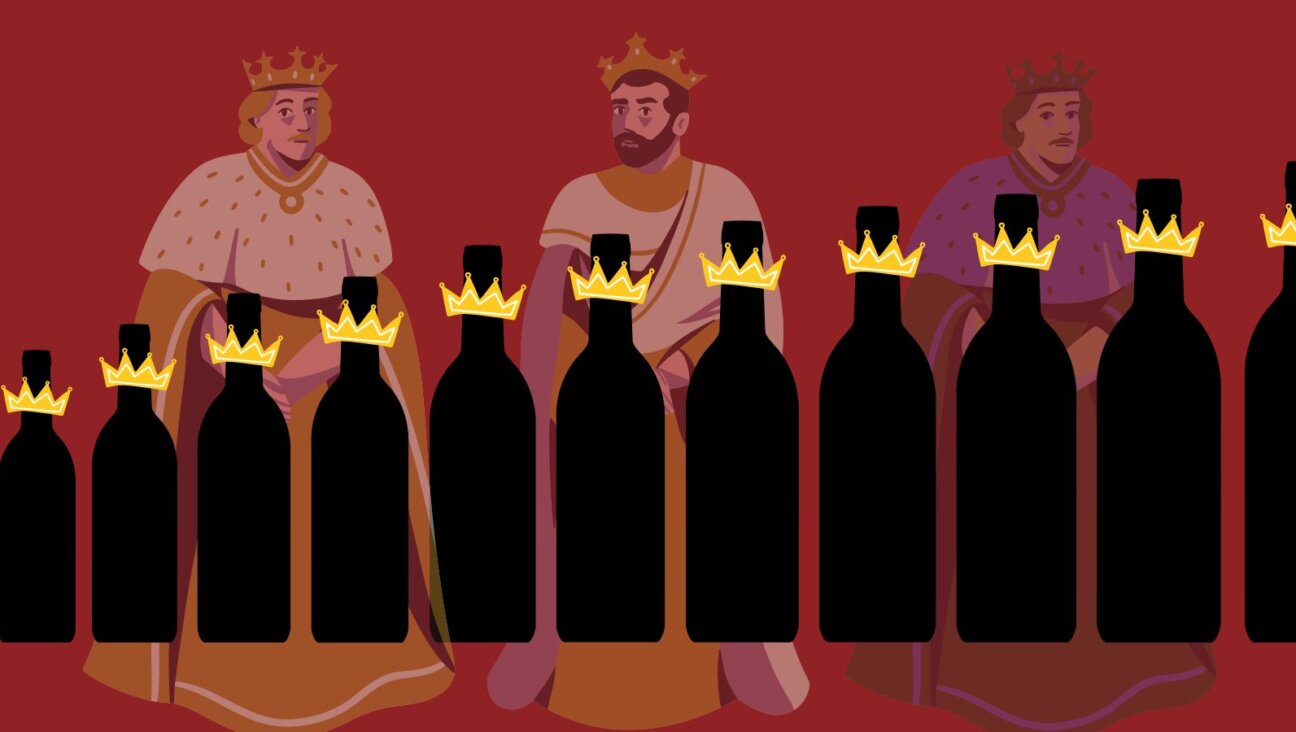Twice Beware the Aryan Nation

?Made In Aryan?, 30? x 24?, acrylic on canvas, 2010. By Joshua H. Stulman.
Thinking about Iran and the Bomb the other day (what newspaper reader doesn’t?), it struck me as a curious coincidence that, for the second time in some of our lifetimes, Jews are being threatened with mass destruction in the name of the same ancient Indo-European word.
This is because “Iran” and “Aryan” are connected. The first ultimately derives from Old Persian arya or ariya, a term designating the Indo-European-speaking people of Persia, and is identical with Sanskrit arya — that is, the Indo-European-speaking people of northern India. Since Old Persian and Sanskrit (which is the mother of such modern Indian languages as Hindi, Punjabi, Gujarati, Marathi and Bengali) are closely related, having been the languages spoken in antiquity by the easternmost branch of the Indo-European linguistic stock, it is not surprising that the speakers of both should have used the same word for themselves.
“Aryan,” on the other hand, is a modern European coinage, strongly tinged by racialist linguistic theories and constructions of history that gained currency in mid-19th-century Europe. Not all these theories were overtly racist in the sense of proposing the innate superiority of any one group of mankind over the others. All did assume, however, a close correlation among race, language, mentality and culture, and all ascribed fundamentally different outlooks and values to the members of different linguistic families. Because Sanskrit was once erroneously considered to be the oldest Indo-European language, arya was widely taken to be the original Indo-European word for Indo-Europeans, and “Aryan” and “Indo-European” became synonymous.

?Made In Aryan?, 30? x 24?, acrylic on canvas, 2010. By Joshua H. Stulman.
Yet as the 19th century progressed, linguists discarded the notion that Sanskrit was any older than Latin, Greek, Old Germanic, Old Slavic or any of the other “second-generation” offspring of a “proto-Indo-European” parent language that no longer existed. Looking for the original homeland of this proto-speech, scholars now argued that it must have been somewhere in Northern or Eastern Europe. Adopted by such openly racist proponents of Nordic or European racial superiority as Arthur de Gobineau and Houston Stewart Chamberlain, this belief became the core of racist ideologies that held, first, that the Indo-European-speaking or Aryan peoples of the world represented a higher form of human development than the speakers of other languages, such as Semitic ones, and second, that the “purest” Aryans were to be found in the blond-haired, blue-eyed inhabitants of Germany and Scandinavia, where the Aryan racial type first hailed from and in which it had remained the least diluted. Joined to the totalitarian politics of the 20th century, such “Aryanism” became part and parcel of Nazi thought, providing a pseudo-scientific basis for a genocidal antisemitism.
Today, we know that, from a strictly scholarly point of view, all this is nonsense. Racial and linguistic families are two quite different things and tend to overlap, at best, only partially; the original Indo-European speakers came, in all likelihood, not from Northern or Eastern Europe, but from either the Anatolian plateau of Turkey or just north of the Black Sea, and arya was never a pan-Indo-European word and had currency only among the ancestors of today’s Iranians and northern Indians, who, thousands of years ago, spread eastward and southward into Asia in successive waves at the same time that other Indo-European speakers were spreading westward and northward into Europe. If an original “Aryan” type ever existed, it was almost certainly not blond haired and blue eyed.
The one thing that has survived all this scholarly debunking is the notion of an Indo-European family of languages in itself. Such a family does indeed exist, and includes all the languages of contemporary Europe, with the exception of Finnish, Lapp, Estonian, Hungarian and Basque, plus Kurdish, Iranian, the various Pashto languages of Afghanistan, the Urdu languages of Pakistan and northwestern India, and the Hindi languages of northern India. Although to the linguistically untrained eye and ear, most of these languages do not look or sound anything like one another, clear traces of their common prehistoric origins remain in their vocabulary and grammar. Thus, for instance, if we look at the word for “mother” in various Indo-European tongues, we find Mutter in modern German, madre in modern Spanish, mathair in modern Gaelic, mat’ in modern Russian, metera in modern Greek, mayr in modern Armenian, madder in modern Persian, etc. Clearly, all these go back to the same proto-Indo-European word.
Why the speakers of ancient Indo-European languages were so successful that today their descendants populate a vast part of the globe is debatable: Theories range from their having been fierce warriors who overran their non-Indo-European-speaking neighbors to their having been peaceable farmers whose superior agricultural skills enabled them to prosper and expand. One thing that is certain is that they never had a common identity or thought of themselves as belonging to a single family. “Aryanism” is a strictly modern, anti-democratic political ideology, as are the politics of the Islamic Republic of Iran. It’s perhaps not such a coincidence, after all, that both have had it in for the Jews.
Questions for Philologos can be sent to [email protected]
More of Joshua H. Stulman’s work can be found at www.joshuastulman.com. His MFA graduate thesis exhibition “How to Paint Moo-Ham-Mud” will be on view at Pratt Institute May 24-28th in the Steuben Gallery.

I hope you appreciated this article. Before you go, I’d like to ask you to please support the Forward’s award-winning journalism this Passover.
In this age of misinformation, our work is needed like never before. We report on the news that matters most to American Jews, driven by truth, not ideology.
At a time when newsrooms are closing or cutting back, the Forward has removed its paywall. That means for the first time in our 126-year history, Forward journalism is free to everyone, everywhere. With an ongoing war, rising antisemitism, and a flood of disinformation that may affect the upcoming election, we believe that free and open access to Jewish journalism is imperative.
Readers like you make it all possible. Right now, we’re in the middle of our Passover Pledge Drive and we need 500 people to step up and make a gift to sustain our trustworthy, independent journalism.
Make a gift of any size and become a Forward member today. You’ll support our mission to tell the American Jewish story fully and fairly.
— Rachel Fishman Feddersen, Publisher and CEO
Join our mission to tell the Jewish story fully and fairly.
Our Goal: 500 gifts during our Passover Pledge Drive!























